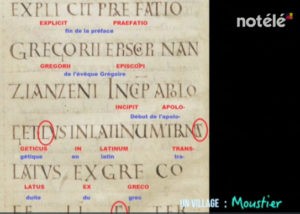Here’s a link to a short video piece on the Moustier cryptograms from November 2015, courtesy of Belgian television network Notélé (Christophe M reminded me of this recently, but Etienne had also noted this here back in July).
Incidentally, I tried to grab the video stream so that I could transcribe the text for you here, but sadly Notélé’s online video streaming software proved to be too cunningly clever for the various Firefox add-ons I tried, so I gave up. *sigh*
Going through the film yielded two things that I didn’t previously know about the Moustier cryptograms:
(1) According to church records, the artisan who did the stonecutting (the film says in “1848”, but I’m sure the actual date was 1838) was a local sculptor called Pierre Brébant (?) from Tournai, a mere 15 miles away from Moustier. (However, I can find no trace of him, please let me know if you can do any better).
(2) Philippe Connart’s theory about the Moustier cryptograms is that their letter-shapes mimic the 10th century Merovingian-era palaeography employed by a monk in the Abbaye at St Amand les Eaux (formerly known as Elnon Abbey or Elnone Abbey), in a copy of works by the 4th century Archbishop of Constantinople Gregory of Nazianzus.
I have to say I’m really not sure that Connart’s hypothesis really hits the spot: it’s a gigantic leap from the 10th century to the 19th century without any kind of obvious intermediary, or motivation, or need, or connection, or indeed boring churchy paperwork to support it. And of the two unusual letters that Connart highlights (a square-cut C and a zigzaggy S), only the first seems to appear in the Moustier carvings, which could easily be coincidental.
But what sits most awkwardly with me about this is that the Moustier carving simply doesn’t look like the work of a sculptor trying to emulate some high-class 10th century writing. Apart from the presence of a few unusual shapes, the carving looks rather amateurish and awkward: the letter-heights are inconsistent, while the letter-shapes also seem somewhat inconsistent.
Anyway, as always, opinions on this differ.
Namurois Crosses?
Incidentally, “La Belgique Mystérieuse” (1973) refers readers interested in the Moustier mystery to look at a number of ancient Namurois crosses whose inscriptions have resisted all interpretation. (“On connait également dans le Namurois plusieurs croix funéraires anciennes dont le texte mystérieux a résisté jusqu’à présent aux tentatives les plus ingénieuses d’interprétation.“). (p.119)
However, the best-known thing fiting that description was La Croix de Saint-Géry near Chastre, which is a 3-metre-tall cross without any trace of writing whatsoever. (Someone hit it with a car in 2013, knocking the top part of the cross clean off: but it has since been re-erected). Unlike Moustier’s curious carvings, the enigma there is simply that nobody has any idea where the cross came from (it was first mentioned in the 16th century, but seems older).
An 1875 letter by Camille Van Dessel (reproduced on p.284 [p.314 of the PDF] here) pointed to a notice by a M. Bamps in the Bulletin des Commissions royales d’art et d’archéologie suggesting two similar monuments:
L’une a été déterrée dans la plaine derrière Boekrak, l’autre à Zonhoven. M. Bamps prétend que ce sont des croix expiatoires, dont la première fut établie à la suite d’un abus de pouvoir du seigneur de Vogelzanck, la seconde à la suite d’un sacrilège commis en enterrant une statue miraculeuse.
Bamps’ note appears in full here (p.105 [p.119 of the PDF]): but both of the mysterious crosses whose histories Bamps tries to trace also have no inscription.
Hence my current belief is therefore that the Moustier set of inscriptions remains entirely unique in Belgium: but please feel free to leave a comment here if you can correct me. 🙂

Hello,
When I listen to the video I hear “Pierre Brébar” and not “Pierre Brébant”.
At Tournai there was a painter Raymond Joseph Brébar (1736-1820) who painted religious subjetcs.
Pierre Brébar could be a member of his family.
Not necessarily inscrutable, but excruciating (for me) because I can’t see what is being spoken (lip and face reading) — I can, however, read the ‘all caps’ words easily. Can you tell us a little more about Connart ?
bd
Christophe: he certainly could have been part of Raymond Joseph Brébar’s family, though I couldn’t find the tiniest trace of “Pierre Brébar”. 🙁
Heh, I had never heard of this. But then again, I’m from the other part of Belgium.
All in all not much seems to be known about this inscription… could it be related to this in any way?
Moustiers est un des rares bourgs de Haute-Provence à accueillir une loge maçonnique avant la Révolution, nommée Les Indissolubles et affiliée à la Grande loge provinciale en 1788.
#Illuminati
Koen: errrm, no, that’s Moustiers-Sainte-Marie in Provence, not the Belgian one. :-/
Ahh, that’s what I get for trying to solve ancient mysteries on my tiny phone screen 🙁
Imagine you’re a 19th-century parish priest overseeing the renovation of his rural church. The work is expensive and the congregation is poor. A local firm has some simple marble blocks which have been used by an apprentice for basic letter-carving practice. The firm is happy to sell them to the parish for a fraction of the normal price. The priest is pleased with the dignified design and not too worried about the meaningless text; the parishioners are most unlikely to object, and the bishop will not mind, since the panels will generally be hidden by cloth altar frontals during Mass.
Anyway, that’s my theory!
JP: unfortunately, the paucity of documentary evidence we have means that this is a perfectly reasonable hypothesis. 😉